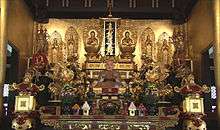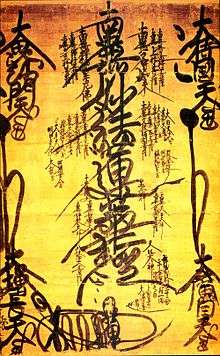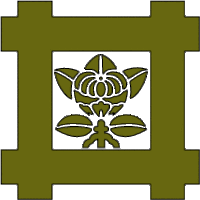Nichiren-shū
Nichiren Shū (日蓮宗, English: School of Nichiren) is a combination of several schools ranging from four of the original Nichiren Buddhist schools that date back to Nichiren's original disciples, and part of the fifth:[2][3][4]
| Name of school | Founder |
|---|---|
| Minobu-san | Nikō |
| Hama-san | Nisshō |
| Ikegami-shu | Nichirō |
| Nakayama-san | Nichijō (also known as Toki Jōni) |
| Fuji-Fuse | Nikkō (in part only) while some belongs to Nichiren Shōshū |
Overview
Among common Nichiren Buddhists, the school is often referred to as the Minobu Sect due to their prominence within the Mount Minobu area. The school's Head Temple, Kuon-ji, is located on Mount Minobu where Nichiren lived in seclusion and where he asked to be buried.[5][6] Another significant temple of Nichiren Shū is the Ikegami Honmon-ji where Nichiren died. Accordingly, many of Nichiren’s most important personal artifacts and writings preserved, also considered to be National Treasures of Japan are within their safekeeping.
The sect is also known for its more open and tolerant views of other Buddhist traditions, even mixing or incorporating various Buddhist beliefs and practices into their own Nichiren Buddhist aesthetics, most notably the use of religious statues, esoteric Buddhist magic rituals and the tolerant photography and distribution of the calligraphic Gohonzon.
| Part of a series on |
| Buddhism in Japan |
|---|
 |
|
Sacred texts
|
Nichiren Shū does not believe Nichiren designated a single successor, as taught for instance by Nichiren Shōshū, rather that he designated six senior disciples to succeed him.
The Six Senior Disciples designated by Nichiren were:
- Nissho (1221–1323)
- Nichiro (1245–1320)
- Nikkō (1246–1333)
- Mimbu Nikō (1253–1314)
- Nitchō (1252–1317)
- Nichiji (1250–unknown)[7]
Nichiren Shū designates the Shakyamuni Buddha of the 16th chapter of the Lotus Sutra as the Eternal Buddha while Nichiren is regarded as the Superior Practice Bodhisattva who is given the mission in chapter 21 of the Lotus Sutra[8] to uphold the true Dharma in the Latter Day of the Law. In addition, Nichiren is seen as the votary of the Lotus Sutra fulfilling its prophecy in acting as the appearance of Bodhisattva Jōgyō ("Superior Practice"), who leads all bodhisattvas in propagating the Lotus Sutra.

Nichiren Shū regards Nichiren as the messenger of the Eternal Shakyamuni Buddha or Original Buddha, but does not consider him as more important than Shakyamuni. The Original Buddha occupies the central role in Nichiren Shū; Nichiren—referred to as Nichiren Shōnin ("Saint Nichiren")—is the saint who refocused attention on Shakyamuni by rebuking other Buddhist schools for solely emphasizing other buddhas or esoteric practices or for neglecting or deriding the Lotus Sutra.
Nichiren Shu regards Nichiren's own writings—called Gosho or Goibun (御遺文)— as commentaries or guides to the doctrines of Buddhism. They include the Five Major Writings of Nichiren in which he establishes doctrine, belief, and practice, as well as many pastoral letters he wrote to his followers. Furthermore, Nichiren Shū is selective about which Gosho writings it deems authentic. Many Gosho writings that are accepted by Nichiren Shōshū are not accepted as genuine by Nichiren Shū on grounds that scholars have not verified their authenticity. The primary reason for this dispute arises over an inability to verify those various disputed writings as actually having been authored by Nichiren. This does not mean those Gosho or alleged oral transmissions (including the Ongi Kuden) are rejected by Nichiren Shū, but it does mean that they are viewed as secondary to authenticated materials and while it is acknowledged they may have pastoral value they cannot be definitively asserted as Nichiren's own teachings.
Religious practices and beliefs
According to Nichiren Shū, there are five kinds of practices that one should perform based on the Lotus Sutra, namely the following:
- Receiving and keeping the Sutra both mentally and physically
- Reading the Sutra visually
- Reciting the Sutra orally
- Explaining the Sutra to others
- Copying the Sutra as a pious act
The primary practice in Nichiren Shū is chanting Odaimoku to an object of devotion. The secondary practice is to chant Chapter 2 (Expedient Means) and Chapter 16 (Life Span of the Thus Come One) of the Lotus Sutra, or any other chapter of The Lotus Sutra or the complete Sutra. Nichiren Shū regards the Odaimoku (the mantra Namu Myōhō Renge Kyō) and the mandala or Gohonzon as the summit of the Dharma, but does not ignore other Buddhist practices.[9] Forms of silent meditation (shōdai-gyō), artistic copying of the Odaimoku (shakyō), and the study of fundamental Buddhist concepts such as the Four Noble Truths, Threefold Training, Noble Eightfold Path and Taking Refuge are used as supporting practices in Nichiren Shū.
Object of worship

Nichiren Shū issues calligraphic Gohonzons to its members, but statue arrangements may also be used to represent the Gohonzon. In Nichiren Shū, the following may be used as the Gohonzon:[10]
- A statue of the Shakyamuni Buddha as the Eternal Buddha, sometimes flanked by the Four Bodhisattvas of the Earth
- A stupa with Namu-myōhō-renge-kyō inscribed on it, flanked by the Buddhas Shakyamuni and Prabhutaratna Buddha
- A single inscription of the Odaimoku (Ippen Shudai)
- The Rin-metsu gohonzon of Nichiren, now claimed as the Shutei Gohonzon of Nichiren Shu[11]
All fully ordained Nichiren Shū ministers are able to inscribe and consecrate mandalas, but in practice few of them do. They usually bestow a copy of a Nichiren inscribed mandala, called the Shutei Gohonzon,[12] upon their members.
Holidays
Holidays observed in Nichiren Shū:
- 15 February — Nirvana Day; death anniversary of Shakyamuni Buddha
- 16 February — Nichiren's birthday
- 21 March — Higan Equinox festival
- 8 April — Buddha's Birthday
- 13–15 July and August — Urabon ancestry festival
- 13 October — death anniversary of Nichiren (Oeshiki)
- 8 December — Bodhi Day
Nichiren Shū temples of historic importance
- Hokekyo-ji, temple safekeeping the original of the Rissho Ankoku Ron, one of Nichiren's most important writings
- Ikegami Honmon-ji, founded on the site where Nichiren passed and was cremated
- Kuon-ji, founded by Nichiren
- Kyōnin-ji, marks the site where Nichiren was attacked in 1281
- Ryūkō-ji, marks the site where Nichiren was to be executed
- Seichō-ji, originally a temple of the Tendai-shū and later Shingon-shū; converted into a temple of the Nichiren-shū in 1949 as it played an important role in Nichiren-Buddhism
- Tanjō-ji, near the site of Nichiren's parental home (the original site is under sea level today)
Nichiren Shū today
Nichiren Shū first spread overseas with Japanese immigrants to the United States, then to the Kingdom of Hawaii, Brazil and other locations in the latter half of the 19th century and the early 20th century. Presently, there are Nichiren Shū temples and Sanghas in the United States, Japan, Canada, Mexico, Costa Rica, much of South America, India, Korea, Southeast Asia (Indonesia, Malaysia, Singapore and Taiwan), and Europe.[13]
Nichiren Shū also ordains non-Japanese and non-Japanese speaking men and women, and continues to expand its presence overseas. Nichiren Shū maintains relations with other Nichiren schools and non-Nichiren schools.
In 2010, Nichiren Shū described itself as a "religious organization consisting of about 5,000 temples, 8,000 ministers and 3.8 million members worldwide."[14]
Differences and similarities with other Nichiren schools
Aside from other fundamental issues on dogma,[15][16][17][18] Nichiren-shū does not believe the Dai-Gohonzon, revered in Nichiren Shōshū, to be superior to other Gohonzons, nor to have been inscribed by Nichiren at all.
Nichiren Shu expresses the disbelief in the superiority of the Dai Gohonzon in that:
Although the Dai Gohonzon in itself is a valid Mandala Gohonzon, this concept of a super Gohonzon that empowers all the others blatantly contradicted Nichiren Daishonin's teachings and, consequently, created a great feeling of mistrust with other Nikko temples.[19]
Nichiren Shu shares similar teachings of Soka Gakkai which states the following:
First, the power of any Gohonzon, including the Dai-Gohonzon, can be tapped only through the power of faith. In other words, we should be clear that it is wrong to think that the Dai-Gohonzon alone has some kind of unique mystic power that no other Gohonzon possesses. The Dai-Gohonzon and our own Gohonzon are equal.[20]
The major difference in Nichiren Shū regards Nichiren as Superior Practice Bodhisattva and teaches that Shakyamuni "... is known as “the” Buddha, not because he attained something that ordinary people cannot attain, but because he was the first person in recorded history to awaken to the truth and to show the way whereby others could do so as well. In that sense, the title “Buddha” is reserved for Shakyamuni simply because he happened to be the one to fulfill the role of teacher and model for all those who follow his path."[21]
Nichiren Shōshū believes that Nichiren was the "Original Buddha of kuon ganjo"[22] while Soka Gakkai views Nichiren as simply an ordinary person who attained Buddhahood, neither which Nichiren Shu accepts.[23] Another difference is that Nichiren Shū disputes the claim of Nichiren Shōshū designating Nikkō as the sole legitimate successor to Nichiren, claiming it is based on counterfeit documents.[24] Furthermore, the authenticity of some of the writings attributed to Nichiren are disputed and therefore considered apocryphal within Nichiren Shū.
A similarity, common to most Nichiren schools, is the shared doctrine of The Three Great Hidden Dharmas,[25] referred to in some schools as the Three Great Secret Laws, as "... it was in order to put the insight of Ichinen Sanzen into actual practice that Nichiren Shonin taught The Three Great Secret Dharmas: the Gohonzon, the Essential Focus of Reverence, the Odaimoku, the great Title of the Lotos Sutra; and the Kaidan, the Precept Platform."[26]
References
- http://nichiren-shu.org/Houston/pages/lineage.htm
- "Nichiren Shu". Archived from the original on 2016-05-15. Retrieved 2010-12-20.
- "Archived copy". Archived from the original on 2012-01-02. Retrieved 2012-01-15.CS1 maint: archived copy as title (link)
- http://www.religionfacts.com/buddhism/sects/nichiren.htm
- http://nichiren-shu.org/AboutUs/major/minobu.html
- Japan National Tourism Organization
- Ryuei Shonin, "On October 8, 1282 at the house of Munenaka Ikegami, Nichiren Shonin designated the Six Senior Disciples (Roku Roso) to carry on his work after his death. These six were: Nissho (1221-1323), Nichiro (1245-1320), Nikkō (1246-1333), Niko (1253-1314), Nitcho (1252-1317), and Nichiji (1250-1305?)."http://nichirenscoffeehouse.net/Ryuei/SixDisciples_01.html Archived 2016-07-13 at the Wayback Machine"
- Nichiren Shonin
- Dharma, Nichiren Shu Service Book, Nichiren Buddhist International Center: ISBN 0-9719645-3-X
- http://nichirenscoffeehouse.net/Gohonzon/EyeOpeningCeremony.html
- Shutei Gohonzon
- Who's Who on the Gohonzon?
- Temples Near You
- Rev. Chishin Hirai, History of Nichiren Shū, Nichiren Buddhist International Center, The Bridge 53, p.1 (2010) PDF
- Nichiren Shū Houston Sangha: ‘The Lineage of Nichiren Buddhism’ http://nichiren-shu.org/Houston/pages/lineage.htm
- Rev. Ryuei: ‘The Six Major Disciples of Nichiren’ http://www.nichirenscoffeehouse.net/Ryuei/SixDisciples_01.html Archived 2016-07-13 at the Wayback Machine
- Rev. Tarabini: ‘A response to questions from Soka Gakkai practitioners regarding the similarities and differences among Nichiren Shu, Nichiren Shōshū and the Soka Gakkai’ http://nichiren-shu.org/NONA/comparison.pdf Archived 2013-06-02 at the Wayback Machine
- Choeizan Enkyoji Nichiren Shu (Series1/Part 4/4) Difference Between Nichiren Shu and Shoshu-SGI https://www.youtube.com/watch?v=S73tXgYpt44
- Rev. Tarabini http://nichiren-shu.org/NONA/comparison.pdf Archived 2013-06-02 at the Wayback Machine page 5
- "Archived copy". Archived from the original on 2012-04-14. Retrieved 2012-03-01.CS1 maint: archived copy as title (link)
- Lotus Seeds: The Essence of Nichiren Shu Buddhism, San Jose, CA: Nichiren Buddhist Temple of San Jose, 2000. ISBN 0970592000, page 61
- http://www.nst.org/glossary/
- Lexington Nichiren Buddhist Community (undated), Jogyo-Shindoku (Traditional Auxiliary Practice), Lexington, Kentucky, p. 20
- Montgomery, Daniel (1991). Fire in the Lotus, The Dynamic Religion of Nichiren. London: Mandala. pp. 147–151, 169. ISBN 1852740914.
- Rev. Ryuei: ‘The Three Great Hidden Dharmas’ http://www.nichiren-shu.org/Sanfrancisco/pages/study/nine.htm
- Lotus Seeds: The Essence of Nichiren Shu Buddhism, San Jose, CA: Nichiren Buddhist Temple of San Jose, 2000. ISBN 0970592000, page 72
External links
- Nichiren Shu
- Nichiren-shū Yahoo group moderated by one of the North American Nichiren-shū ministers
- Copy of a Gohonzon inscribed by Nichiren
- Website of one of Nichiren-shū's North American ministers
- Nichiren Buddhist Sangha of Greater New England
- Nichiren-shū in Italy and Europe, website in Italian, English, French and Spanish
- Nichiren-shū in the UK
- Nichiren Shu Brasil
- Nichiren Shu In Indonesia
- Namu Myoho Renge Kyo
- Nichiren Sangha, website in English and Spanish
- 資料集

